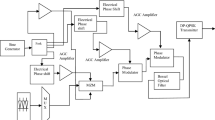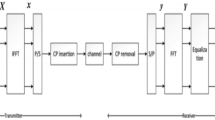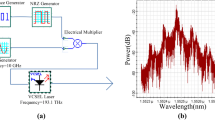Abstract
Low loss and ultra-high bandwidth available in optical domain has led to the shift from electrical signal processing such as modulation, bandwidth allotment etc. toward all optical processing. Implementing millimeter-wave (mm-wave) signals along with advanced modulation techniques to modulate the light has led to the development of technologies such as Radio over Fiber (RoF), Passive Optical Network (PON) and finds application in present and future broadband communication. In this paper a full-duplex 20 Gbit/s RoF system is presented for a transmission distance up to 100 km and overall system performance is studied in terms of Q-factor, Bit Error Rate (BER) and Error Vector Magnitude based on simulation platform. It is observed that the system maintains good performance in terms of coherency (i.e. single laser source) and spectral efficiency (bits/s/Hz) after transmission over Standard Single Mode Fiber (SSMF). Findings are useful to design high speed, lesser bandwidth, and cost-efficient optical communication system. The same can also be implemented in WDM system to get a much higher data rate of 320 Gbps for system using 16 channels.
Access provided by CONRICYT-eBooks. Download conference paper PDF
Similar content being viewed by others
1 Introduction
Recently, the information processing and communication society highly rely on broadband communication solutions such as interactive multimedia services, network games, High Definition Television (HDTV) distribution which require very high bandwidth and with the increasing number of users the network traffic is growing exponentially [1]. So for comparing the technologies available at present, one way is to consider the system parameters such as bit rate, regeneration-free transmission distance and cost of the implementation. One way of implementing cost effective transmission is to make the remote base stations as simple as possible and network functions such as signal processing, frequency allocation is carried out at the center station. The other way is to implement advanced modulation schemes owing to their high data rate and tolerance to fiber impairments such as attenuation and dispersion. In this paper, we have implemented Differential Quaternary Phase Shift Keying (DQPSK) so that with increased data rate, direct detection is also possible. There are two advantages, (1) multiple data is transmitted per sample and (2) in terms of coherency because the uplink carrier signal is preserved in the downlink signal and single laser source. Furthermore, differential phase modulation technology is found to have excellent transmission characteristics and 3 dB enhanced reception accuracy [2]. The mm-wave along with higher data rate capability is used for avoiding the spectral congestion in the lower frequency bands. The RoF technology allows a dynamic radio resource configuration and capacity allocation. It also eliminates the need for local oscillator at the radio access unit. In the later part, the same system may be incorporated to design a Wavelength Division Multiplexing (WDM) system and have a higher bit rate and more number of carriers transmitted through a SSMF. The polarization multiplexing technology increases the capacity of the single carrier to two times. The demodulation procedure includes Mach-Zehnder Interferometer (MZI) demodulator, followed by balanced Photo Detector (PD) and decision logic [3]. To eliminate the issue of generating electrical mm-wave of required range 40–60 GHz as this exceeds the limit of electrical devices, we preferred to generate it in optical domain by means of optical heterodyne beating [4].
The paper is organized as follows. Section 2 describes the working principle of the designed full-duplex wired communication system theoretically. Section 3 presents the simulation of the proposed system along with the results.
2 Principle of Operation
Figure 1 shows the schematic of the proposed full-duplex link. The lightwave emitted from the CW Laser has a central frequency of \(f_{0} = \omega_{0} /2\pi\) and the emitted lightwave can be expressed as \(E_{0} (t) = E_{0} e^{{j\omega_{0} t}}\). Then it is provided to both the DQPSK modulator where the data rate is half of the input data rate. The Serial to Parallel (S/P) Converter converts the input bit stream into two output sequence of half the input bit rate. The drive waveform of the LiNbO3 Mach-Zehnder Modulator (MZM) is in Non-Return to Zero (NRZ) format pulses \(p(t) = \sin (\pi t/T_{S} )\), where \(T_{S}\) is the symbol period [5].
Design of the proposed full-duplex optical fiber link [5], where, serial to parallel converter (S/P), delay interleaver (IL), in-phase and quadrature modulator (I/Q), electrical band-pass filter (EBPF), optical band-pass filter (OBPF), Mach-Zehnder interferometer (MZI), balanced photo-detector (PD)
At the transmitter output the downlink data can be expressed in terms of In-phase and Quadrature components as below [3]:
Here, \(a_{I,n}\) and \(a_{Q,n}\) are the data symbol transmitted in-phase and quadrature components at time \(kT_{s}\). The in-phase and quadrature components are multiplied with mm-wave sinusoidal carrier of \(V_{m} (t) = V_{m} \cos \omega_{m} t\) and \(V_{m} (t) = - V_{m} \sin \omega_{m} t\) represented as [3]:
where, \(\varphi_{i} (t) = \arctan \{ Q(t)/I(t)\} = \pi /4,3\pi /4,5\pi /4\) and \(7\pi /4\) for i = 1, 2, 3 and 4 respectively. If we represent fiber length by z, the transmission function can be represented as:
where, \(\alpha\) is the attenuation coefficient and \(\beta (\omega )\) is propagation constant at angular frequency of \(\omega\). The DQPSK mm-wave can be represented in optical domain as [3]:
Here, \(\omega_{0} + \omega_{m}\) represents 1st order sideband, \(F\{ \}\) is forward Fourier transform and \(F^{ - 1} \{ \}\) is inverse Fourier transform. \(E_{C}\) and \(E_{S}\) correspond to carrier and baseband signals.
The same system can be implemented in WDM System for increasing the data rate. Moreover, it is useful in the context of frequency reuse environments where multiple frequency generation and simple base station is a major factor. The function of the WDM multiplexer (MUX) is to combine all the channel wavelengths and transmit over the fiber. Figure 2 shows a simplex WDM implementation of the proposed system.
3 Simulation Setup and Results
To check the system performance, the design is implemented on OptiSystem V13 simulation platform. The full-duplex link uses two wavelengths that makes the system to communicate in both directions simultaneously. The laser has a central wavelength of 193.1 THz and linewidth of 0.1 MHz which is injected to the LiNbO3 MZM that has a half wave voltage of 4 V. The oscillator produces a sine wave of frequency of one fourth of bit rate (i.e. bit rate/4) and it modulates the optical carrier to produce the required mm-wave. The resulting signal is applied to the two parallel Dual Drive LiNbO3 MZM where the electrical converted data stream is imprinted to the optical carrier. Then modulated data is transmitted over the SSMF having attenuation of 0.2 dB/km and a dispersion of 16.75 ps/nm-km. Figure 3 shows the eye diagram for various fiber lengths of 20, 60, 80 and 100 km respectively. It is clearly visible that the system maintains a good performance which have been shown through Q-factor and BER.
Table 1 shows various parameters that represents transmission quality of the system in terms of Eye opening (Height peak to peak) which measure the additive noise in the signal, Quality factor (vertical eye opening in comparison to the noise present), and BER.
The Error Vector Magnitude (EVM) is basically a standardized error magnitude between the experimentally observed constellation and with difference to ideal constellation and can be calculated from optimized constellation diagram. The magnitude error, phase error and EVM can be expressed as [6] (Fig. 4):
A graph is plotted for various received power versus EVM (%) for various fiber lengths as in Fig. 5. A maximum distance of 100 km is achieved and the system performance is tested for 0, 50 and 100 km. It is seen that when the received power becomes less the system is more prone to error. The receiver sensitivity is found to be −20 dBm for achieving a BER of 10−6 i.e. an EVM of 20%. Below this power level the BER of the system changes abruptly. Then a simple implementation for WDM simplex system is done and its performance is evaluated for wavelengths λ1 = 1552.4 nm to λ16 = 1564.67 nm in the C-band. The frequency separation for different wavelength is set at a separation of 0.8 nm (100 GHz). The dispersion effects have been compensated with the implementation of Dispersion Compensating Fiber (DCF) which has a negative dispersion co-efficient of −85 ps/nm/km and the fiber attenuation is combated with the help of Erbium Doped Fiber Amplifier (EDFA) with a gain of 4 dB at regular intervals. With attenuation and dispersion compensation the transmission distance can be extended to 140 km over SSMF.
4 Conclusion
This paper implements a full-duplex RoF network architecture design with 20 Gbps DP-DQPSK down link and 5 Gbps up-link data rates. The laser free user terminal with direct detection makes it useful in lesser complexity and low cost base stations, reduced phase noise and also good coherence due to same optical source. From the performance analysis based on simulation platform the designed system can be realized for bidirectional transmission with 100 km fiber transmission and for WDM system with attenuation and dispersion compensation a maximum data rate of 320 Gbps for 140 km is achieved.
References
Winzer, P. J. and Essiambre, R. J., “Advanced Optical Modulation Formats,” proc. of the IEEE, Vol. 94, No. 5 (2006).
Li, L., Jin-ling, C. and Ji-jun, Z, “Research of 100 Gbit/s DP-QPSK Based on DSP in WDM-PON System,” International Journal of Signal Processing, Vol. 8, No. 3, 121–130 (2015).
Zhang, R., Ma, J. and Xin, X., “Full-Duplex Fiber-Wireless link for alternative wired and 40 GHz wireless access based on Differential Quaternary Phase Shift Optical Single sideband millimeter wave signal”, Optical Engineering vol. 54, No. 2, 026101–10 (2015).
Ma, J., Zhan, Y., Zhou, M., Liang, H., Shao, Y. and Yu, C., “Full-Duplex Radio Over Fiber with a Centralized Optical Source for a 60 GHz Millimeter-Wave System with a 10 Gbps 16-QAM Downstream Signal Based on Frequency Quadrupling,” J. Opt. Commun. Netw., Vol. 4, No. 7, 557–564 (2012).
Chen, A. and Murphy, E. J., [Broadband Optical Modulators], CRC press, Taylor and Francis Group, New York (35–54).
Chang, P. H. and Cho, G. R., “Enhanced feedforward control of non-minimum phase systems for tracking predefined trajectory,” International Journal of Control, Vol. 83, No. 12, 2440–2452 (2010).
Author information
Authors and Affiliations
Corresponding author
Editor information
Editors and Affiliations
Rights and permissions
Copyright information
© 2017 Springer Nature Singapore Pte Ltd.
About this paper
Cite this paper
Kakati, D., Arya, S.C. (2017). Full-Duplex 20 Gbit/s Fiber-Optic Link Design Based on Dual-Polarization Differential Quaternary Phase-Shift Keying. In: Bhattacharya, I., Chakrabarti, S., Reehal, H., Lakshminarayanan, V. (eds) Advances in Optical Science and Engineering. Springer Proceedings in Physics, vol 194. Springer, Singapore. https://doi.org/10.1007/978-981-10-3908-9_72
Download citation
DOI: https://doi.org/10.1007/978-981-10-3908-9_72
Published:
Publisher Name: Springer, Singapore
Print ISBN: 978-981-10-3907-2
Online ISBN: 978-981-10-3908-9
eBook Packages: Physics and AstronomyPhysics and Astronomy (R0)









